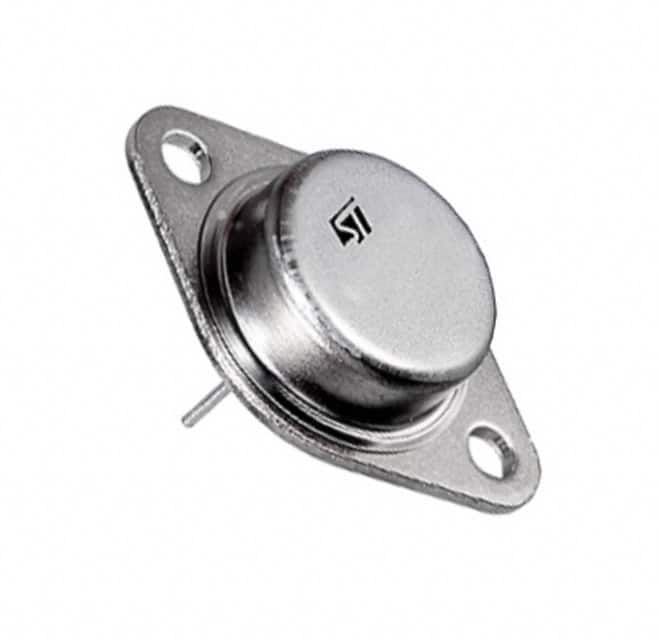Lihat spesifikasi untuk detail produk.

2N3772 Transistor
Product Overview
The 2N3772 is a power transistor belonging to the category of bipolar junction transistors (BJTs). It is commonly used in electronic circuits for amplification and switching applications. The transistor exhibits high current and voltage capabilities, making it suitable for power amplifier and high-speed switching circuits. The 2N3772 is typically housed in a TO-3 metal package, which provides efficient heat dissipation, essential for high-power applications.
Characteristics
- Category: Bipolar Junction Transistor (BJT)
- Use: Power amplification and high-speed switching
- Package: TO-3 metal package
- Essence: High current and voltage capabilities
- Packaging/Quantity: Typically sold individually or in small quantities
Specifications
The 2N3772 transistor has the following key specifications: - Collector-Emitter Voltage (Vce): 40V - Collector Current (Ic): 30A - Power Dissipation (Pd): 150W - Transition Frequency (ft): 3MHz - Operating Temperature Range: -65°C to 200°C
Pin Configuration
The 2N3772 transistor features a standard three-pin configuration: 1. Base (B) 2. Emitter (E) 3. Collector (C)
Functional Features
The 2N3772 transistor offers the following functional features: - High current and voltage handling capabilities - Fast switching speed - Low saturation voltage - Robust construction for reliable performance in demanding applications
Advantages and Disadvantages
Advantages
- High power handling capacity
- Fast switching speed
- Low saturation voltage
- Reliable performance in high-power applications
Disadvantages
- Relatively larger package size compared to smaller transistors
- Higher cost compared to low-power transistors
Working Principles
The 2N3772 operates based on the principles of bipolar junction transistors. When a small current flows into the base terminal, it controls a much larger current flowing between the collector and emitter terminals. This property allows the transistor to amplify signals or control the flow of larger currents in switching applications.
Application Field Plans
The 2N3772 transistor finds extensive use in various applications, including: - Power amplifiers - Switching regulators - Motor control circuits - Audio amplifiers - High-power LED drivers
Alternative Models
Several alternative models can be used as substitutes for the 2N3772, including: - MJ15003 - 2SC5200 - TIP35C - MJE15032
In conclusion, the 2N3772 transistor is a versatile component with high power-handling capabilities, making it well-suited for power amplification and high-speed switching applications.
Word Count: 411
Sebutkan 10 pertanyaan dan jawaban umum terkait penerapan 2N3772 dalam solusi teknis
What is the 2N3772 transistor used for?
- The 2N3772 is a high-power NPN bipolar junction transistor commonly used in power amplifier and switching applications.
What are the key specifications of the 2N3772 transistor?
- The 2N3772 has a maximum collector current of 30A, a maximum collector-emitter voltage of 40V, and a maximum power dissipation of 150W.
Can the 2N3772 be used in audio amplifier circuits?
- Yes, the 2N3772 is suitable for use in audio amplifier circuits due to its high power handling capabilities.
How can the 2N3772 be used in a switching application?
- The 2N3772 can be used in switching applications to control high-power loads such as motors or solenoids.
What are the typical operating conditions for the 2N3772?
- The 2N3772 is typically operated with a base current of 3A and a collector-emitter voltage of 20V.
Are there any common failure modes associated with the 2N3772?
- Common failure modes include thermal runaway due to excessive heat buildup and overvoltage breakdown.
Can multiple 2N3772 transistors be paralleled for higher power applications?
- Yes, multiple 2N3772 transistors can be paralleled to increase the overall power handling capability of the circuit.
What are some typical heat dissipation considerations when using the 2N3772?
- Heat sinks are often required to dissipate the heat generated by the 2N3772, especially in high-power applications.
Is the 2N3772 suitable for automotive applications?
- Yes, the 2N3772 is commonly used in automotive applications such as motor control and power distribution.
Where can I find detailed application notes for using the 2N3772 in technical solutions?
- Detailed application notes for the 2N3772 can be found in the manufacturer's datasheet and application guides, as well as in technical reference books on power transistors and amplifier design.

